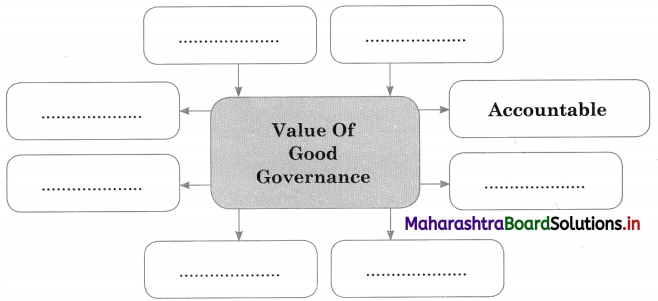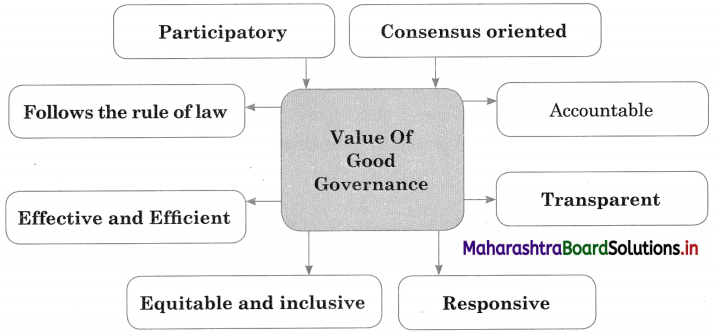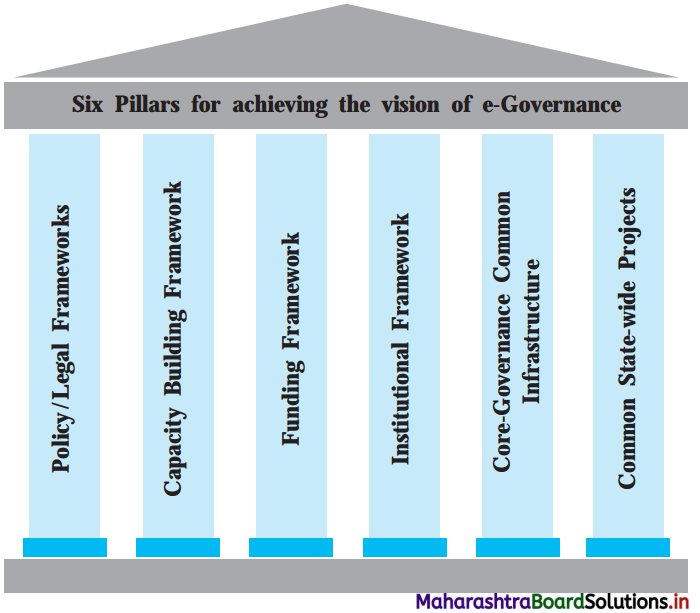Balbharti Maharashtra State Board Class 12 Political Science Important Questions Chapter 5 Contemporary India: Good Governance Important Questions and Answers.
Maharashtra State Board 12th Political Science Important Questions Chapter 5 Contemporary India: Good Governance
Complete the following statements by selecting the appropriate option.
Question 1.
The concept of ‘citizens charter’ is part of
(a) POSDCORB
(b) development administration
(c) good governance
(d) NGO activity
Answer:
(c) good governance
Question 2.
The good governance model looks at inter-linkages between the government and
(a) civil society
(b) political parties
(c) public administration
(d) human rights
Answer:
(a) civil society
![]()
Question 3.
The culture of ‘secrecy’ in administration has been challenged by the good governance value of
(a) effectiveness
(b) transparency
(c) accountability
(d) equity
Answer:
(b) transparency
Question 4.
The Consumer Protection Act was passed in the year
(a) 1986
(b) 1990
(c) 2000
(d) 2012
Answer:
(a) 1986
Identify the incorrect pair in every set and correct it.
Question 1.
(a) Lokayuktas – States
(b) Fundamental duties – good governance
(c) E-governance – Digitisation of records
(b) Directive Principles of State Policy – good governance
Answer:
(b) Fundamental duties – good governance
Complete the following sentences by selecting the appropriate reason.
Question 1.
Governance is a broader view of public administration because ………………
(a) it includes not only formal institutions of government but also informal institutions.
(b) it is based on e-governance.
(c) it was introduced after the second ARC.
Answer:
(a) it includes not only formal institutions of government but also informal institutions.
![]()
State the appropriate concept for the given statements.
Question 1.
Wide range of organisations such as labour unions, NGO’s etc.
Answer:
Civil Society
Question 2.
Institution created in India in 2013 to inquire into allegations of corruption against officials at union level.
Answer:
Lokpal
Question 3.
Governance facilitated by I.C.T.
Answer:
e-governance
Question 4.
Act of 2005 that enables citizens to seek important public information from the government.
Answer:
Right to Information Act
Find the odd word.
Question 1.
Religious groups, Bur6aucracy, Professional groups, NGO’s.
Answer:
Bureaucracy (not included in civil society / non-state actors)
![]()
Question 2.
Buddhists, Christians, Hindus, Jains.
Answer:
Hindus (not included in religious minorities in India)
Question 3.
Secrecy, Efficiency, Responsiveness, Inclusiveness.
Answer:
Secrecy (not a core value of good governance)
Question 4.
Policy framework, Funding framework, Institutional framework, Redressal and grievances framework
Answer:
Redressal and grievances framework (not a pillar of e-governance)
Complete the concept maps
Question 1.

Answer:

State whether the following statements are true or false with reason.
Question 1.
Good governance approach is a break from the traditional model of public administration.
Answer:
This statement is True.
- Good governance approach aims to improve the performance of public institutions by making administration citizen-centered and not merely rule-bound.
- It aims to replace traditional administration that was archaic and riddled with red tapism and corruption with participative, responsive, equitable and transparent administration.
![]()
Question 2.
E-governance has brought administration closer to people.
Answer:
This statement is True.
- E-governance refers to good governance which is facilitated using Information and Communications Technology (ICT) This helps in the instantaneous transmission, processing, storage and retrieval of data.
- The objective of the National e-governance Plan of Government of India is to bring public service closer home to citizens. This can be done by building a countrywide infrastructure and large scale digitisation of records to enable easy, reliable access over the Internet for e.g., passport application can be done online.
Question 3.
Right to Information is the key to strengthening participatory democracy.
Answer:
This statement is True.
- Right to Information Act, 2005 has enabled citizens to seek important public information from the government and helps to usher in people-centered governance.
- R.T.I is a basic necessity of good governance as it helps to bring transparency in government organisations and makes them function in an efficient, responsive manner.
Explain the correlation between the following.
Question 1.
Good Governance – Traditional model of administration.
Answer:
The concept of development administration brought in changes in the traditional role of administration. Governance refers to the cooperative effort of government as well as non¬government bodies in public administration. Since the traditional approach of public administration was archaic, riddled with red tapism and corruption it would not satisfy the requirements of the citizens. The good governance model is based on core values of efficient, effective, responsible, responsive, transparent and accountable public administration.
Question 2.
Citizen participation – Good governance.
Answer:
In development administration, not only the government but also citizens and NGO’s play a vital role. The term ‘governance’ is used to describe this cooperative effort of the government and non¬governmental bodies in public administration.
The Good Governance approach aims at the following-
- to reform the traditional, huge-sized public administration which was riddled with red tape and corruption
- to replace the archaic systems with responsible, participative and equitable systems
- to look at interlinkages between government and civil society
- to make the administration citizen-centered and not rule bound.
Citizen participation refers to the following aspects-
- the development process is a ‘bottom-up’ approach in which citizens are not recipients but participants in this process
- citizens have a right in making decisions pertaining to themselves
- there are modalities by which citizens can take control of resources and influence decision making
- it contributes to a responsive, participative democracy.
![]()
Question 3.
Good Governance – Right to Information. (RTI)
Answer:
In development administration, not only the government but also citizens and NGO’s play a vital role. The term ‘governance’ is used to describe this cooperative effort of the government and non¬governmental bodies in public administration.
The Good Governance approach aims at the following-
- to reform the traditional, huge-sized public administration which was riddled with red tape and corruption.
- to replace the archaic systems with responsible, participative and equitable systems.
- to look at interlinkages between government and civil society.
- to make the administration citizen-centered and not rule bound.
The R. T. I became operative w.e.f. 12th October 2005. The main objectives of the R.T.I is for citizens to secure access to information under control of public authorities so as to increase citizens awareness and ability to exercise their other rights. It is a basic necessity of good governance which enables citizens to seek important public information from the government i.e., about public policies and actions Transparency in government institutions makes them function more objectively and enables citizens to participate effectively in the governance process.
R.T.I. is an implied fundamental right under the constitution i.e., a part of Article 19 (1) (a) as well as of Article 21. It grants access to information held by a public authority so as to promote openness, transparency and accountability in administration. According to the UN Commission on Human Rights, “Good governance creates an enabling environment conducive to the enjoyment of human rights and prompts growth and sustainable development”. Thus R.T.I. helps in good governance.
Express your opinion of the following.
Question 1.
The National Commission for Minorities (NCM) is an important institutional mechanism towards good governance.
Answer:
I agree with this statement.
The NCM was set up by the Union Government under National Commission for Minorities Act (1992). It monitors the working of safeguards for religious minorities (i.e. Muslim, Christian, Sikh, Buddhist, Zoroastrian (Parsis) and Jain). It looks into specific complaints regarding deprivation of rights of the minorities and takes up such matters with the appropriate authorities. The NCM enables that benefits of good governance must be available to all sections of society, especially to minorities.
Answer the following question in 80 to 100 words.
Question 1.
Elaborate on e-Governance.
Answer:
In the last few decades, governance has become more complex and varied. Citizens expectations from the government have also increased. Information and Communications Technology (ICT) is used in governance. This is called ‘e-governance’. It helps in-
- instant transmission and processing information and efficient storing and retrieval of data.
- increasing the reach of government both geographically and demographically.
- speeding up decision making and increasing transparency and accountability of government processes. E-governance in India has evolved from computerisation of departments to initiatives which are citizen centric and service oriented.

The Government of Maharashtra has identified six priority pillars to use e-governance so as to become proactive and responsive to its citizens’ needs.
Pillar – 1: Establishment of Policy/Legal Frameworks: Legal Framework has to be updated regularly with changing times and technologies.
Pillar – 2: Develop Strong Capacity Building Framework: Capacity Building of employees is necessary.
Pillar – 3: Facilitate abundant Funding: Ensure mechanisms for provision of adequate and timely funds.
Pillar – 4: Institutional Framework: Develop administrative structures that are capable of envisioning and guiding the e-Governance programs.
Pillar 5 – Build Core e-Governance Common Infrastructure: Develop the core e-Governance infrastructure like Data Centre, Common Service Centres and State Wide Area Network etc.
Pillar 6 – Develop Common Statewide Projects: Develop applications like e-Tendering, e-Office, SMS gateway, payment gateway etc. that are common to majority of State departments to ensure coordination.
![]()
Question 2.
Discuss the initiatives for good governance in India.
Answer:
After independence, India adopted a socialist model of development aimed at achieving a Welfare State. The Department of Administrative Reforms and Public Grievances looks after administrative reforms in India. It’s objectives are-
- to promote administrative reforms in government policies and processes.
- to promote citizen-centric governance.
- to conduct innovations in e-governance.
The Second Administrative Reforms Commission (ARC) was set up in 2005 to prepare a blueprint for revamping the public administration system in India. It looked at the following issues.
- To make public administration accountable, transparent, efficient, responsive and result- oriented.
- Citizen centric, participative administration.
There have been a large number of reform measures which have sought to bring administration closer to the people. Broadly these initiatives include :
- Enacting laws giving certain rights to people.
- Setting up of new institutional mechanisms to redress citizens’ grievances.
- Improving accessibility to citizens by setting up units closer to people.
- Simplifying procedures to reduce bureaucratic delays.
- Using technology to improve internal efficiency.
- Reducing regulatory control.
- Holding public contact programmes etc.
Question 3.
Find out examples of the reforms that have been initiated for each of the measures stated below.
Answer:
- Enacting laws giving rights to people – Reform initiated – Right to Information (2005).
- Setting up of new institutional mechanisms to redress citizens’ grievances – Reform initiated: Creating commissions like NHRC, NCW, NCM, etc.
- Improving accessibility to citizens by setting up units closer to people – Reform initiated: Building a countrywide infrastructure reaching down to the remotes areas.
- Simplifying procedures to reduce bureaucratic delays – Reform initiated: Formulation of Citizen’s Charters to specify service standards.
- Using technology to improve internal efficiency – Reform initiated: e-governance i.e., use of Information and Communications Technology (I.C.T) to enable easy access over the internet.
- Improving discipline within the organisation – Reform initiated: Establishing body of Lokpal for the Union and Lokayukta for States.
![]()
Answer the following question with reference to the given points.
Question 1.
Discuss in detail the following specific programmes aimed at bringing good governance in India.
(a) Lokpal and Lokayukta
(b) Right to Information
(c) E-Governance
(d) Citizen’s Charters
Answer:
After independence, India adopted a socialist model of development aimed at achieving a Welfare State. The Department of Administrative Reforms and Public Grievances looks after administrative reforms in India. Its objectives are-
- to promote administrative reforms in government policies and processes.
- to promote citizen-centric governance.
- to conduct innovations in e-governance.
The Second Administrative Reforms Commission (ARC) was set up in 2005 to prepare a blueprint for revamping the public administration system in India. It looked at the following issues.
- to make public administration accountable, transparent, efficient, responsive, and result-oriented.
- citizen-centric, participative administration.
(a) Lokpal and Lokayukta – The Lokpal and Lokayuktas Act (2013) provides for the establishment of Lokpal (central government) and Lokayuktas (States) to inquire into allegations of corruption against public officials in a commitment to responsive, clean governance. The Maharashtra Lokayukta Institution came into being in 1972.
(b) Right to Information – It is a basic necessity of good governance which enables citizens to seek important public information from the government i.e., about public policies and actions. Transparency in government institutions makes them function more objectively and enables citizens to participate effectively in the governance process.
(c) E-Governance In the last few decades, governance has become more complex and varied. Citizens’ expectations from the government have also increased. Information and Communications Technology (ICT) is used in governance. This is called ‘e-governance’. It helps in-
- instant transmission and processing information and efficiently storing and retrieval of data.
- increasing the reach of government both geographically and demographically.
- speeding up decision-making and increasing transparency and accountability of government processes. E-governance in India has evolved from the computerization of departments to initiatives that are citizen-centric and service-oriented.
(d) Citizen’s Charters – The exercise to formulate citizen’s charters began in 1996. Each organization must spell out the services it has to perform and the standards/norms for these services. If these standards are not met then that agency can be held accountable.